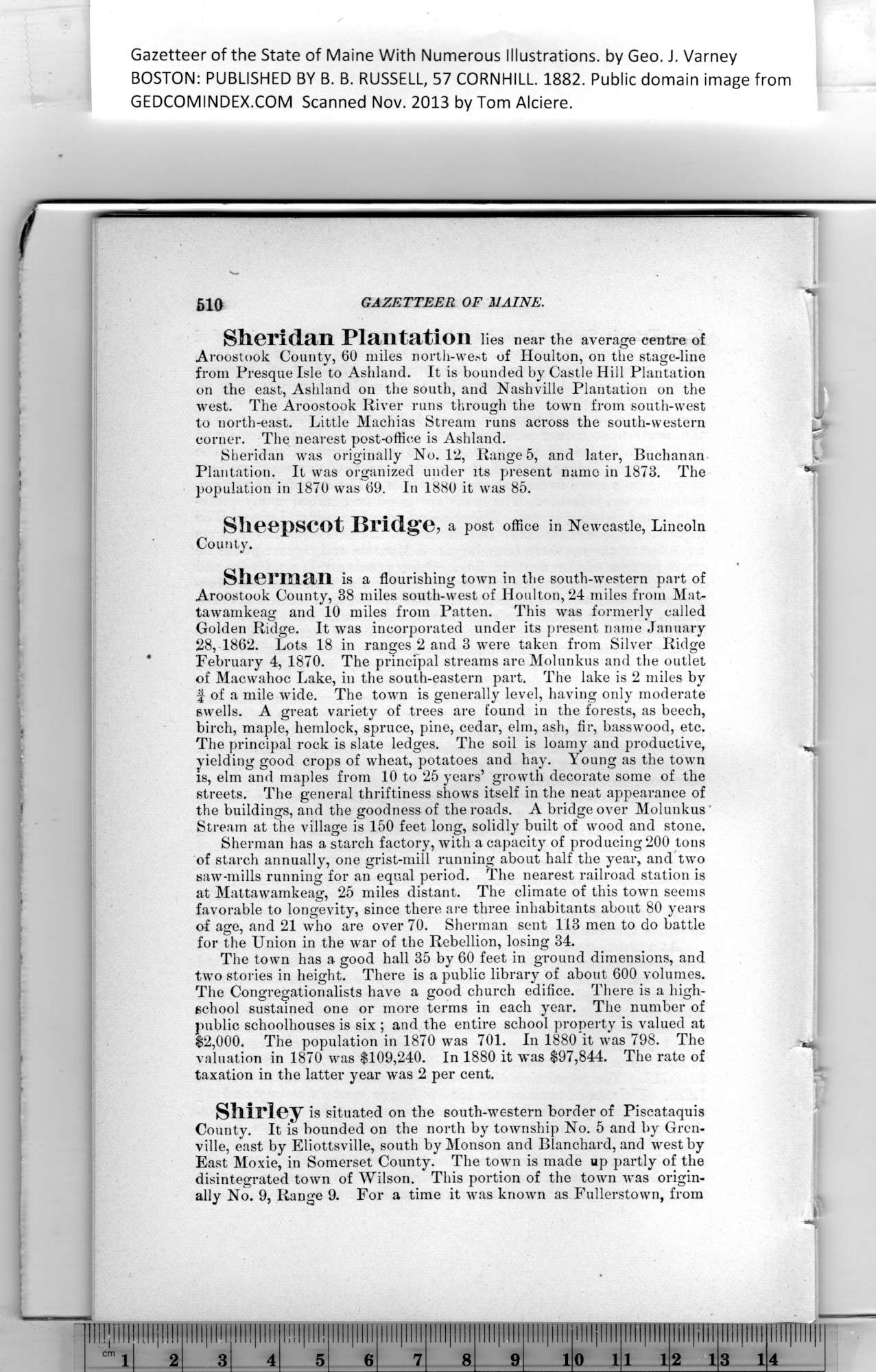|
Gazetteer of the State of Maine With Numerous Illustrations, by Geo. J. Varney
BOSTON: PUBLISHED BY B. B. RUSSELL, 57 CORNHILL. 1882. Public domain image from
510 GAZETTEER OF MAINE.
Sheridan Plantation lies near the average centre of
Aroostook County, 60 miles north-west of Houlton, on the stage-line
from Presque Isle to Ashland. It is bounded by Castle Hill Plantation
on the east, Ashland on the south, and Nashville Plantation on the
west. The Aroostook River runs through the town from south-west
to north-east. Little Machias Stream runs across the south-western
corner. The nearest post-office is Ashland.
Sheridan was originally No. 12, Range 5, and later, Buchanan
Plantation. It was organized under its present name in 1873. The
population in 1870 was 69. In 1880 it was 85.
Sheepscot Bridge, a post office in Newcastle, Lincoln
County.
Sherman is a flourishing town in the south-western part of
Aroostook County, 38 miles south-west of Houlton, 24 miles from Mat-
tawamkeag and 10 miles from Patten. This was formerly called
Golden Ridge. It was incorporated under its present name January
28, 1862. Lots 18 in ranges 2 and 3 were taken from Silver Ridge
February 4, 1870. The principal streams are Molunkus and the outlet
of Macwahoc Lake, in the south-eastern part. The lake is 2 miles by
f of a mile wide. The town is generally level, having only moderate
swells. A great variety of trees are found in the forests, as beech,
birch, maple, hemlock, spruce, pine, cedar, elm, ash, fir, basswood, etc.
The principal rock is slate ledges. The soil is loamy and productive,
yielding good crops of wheat, potatoes and hay. Young as the town
is, elm and maples from 10 to 25 years’ growth decorate some of the
streets. The general thriftiness shows itself in the neat appearance of
the buildings, and the goodness of the roads. A bridge over Molunkus
Stream at the village is 150 feet long, solidly built of wood and stone.
Sherman has a starch factory, with a capacity of producing 200 tons
of starch annually, one grist-mill running about half the year, and two
saw-mills running for an equal period. The nearest railroad station is
at Mattawamkeag, 25 miles distant. The climate of this town seems
favorable to longevity, since there are three inhabitants ahout 80 years
of age, and 21 who are over 70. Sherman sent 113 men to do battle
for the Union in the war of the Rebellion, losing 34.
The town has a good hall 35 by 60 feet in ground dimensions, and
two stories in height. There is a public library of about 600 volumes.
The Congregationalists have a good church edifice. There is a liigh-
scbool sustained one or more terms in each year. The number of
public schoolhouses is six ; and the entire school property is valued at
$2,000. The population in 1870 was 701. In 1880 it was 798. The
valuation in 1870 was $109,240. In 1880 it was $97,844. The rate of
taxation in the latter year was 2 per cent.
Shirley is situated on the south-western border of Piscataquis
County. It is bounded on the north by township No. 5 and by Gren-
ville, east by Eliottsville, south by Monson and Blanchard, and west by
East Moxie, in Somerset County. The town is made up partly of the
disintegrated town of Wilson. This portion of the town was origin-
ally No. 9, Range 9. For a time it was known as Fullerstown, from
PREVIOUS PAGE ... NEXT PAGE
This page was written in HTML using a program written in Python 3.2
|
